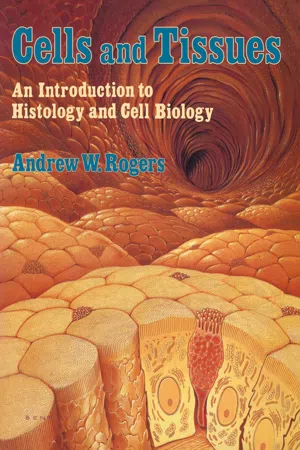Biological Sciences
Cell Structure
Cell structure refers to the arrangement and organization of the various components within a cell. These components include the cell membrane, cytoplasm, organelles such as the nucleus, mitochondria, and endoplasmic reticulum, as well as other structures that carry out specific functions. Understanding cell structure is fundamental to comprehending the processes and functions of living organisms at the cellular level.
Written by Perlego with AI-assistance
Related key terms
1 of 5
8 Key excerpts on "Cell Structure"
- eBook - PDF
Biomaterials Science and Tissue Engineering
Principles and Methods
- Bikramjit Basu(Author)
- 2017(Publication Date)
- Cambridge University Press(Publisher)
SECTION III Fundamentals – Biological Science 225 Cells, Proteins and Nucleic Acids: Structure and Properties I n the context of biomaterials science, it is important to introduce the relevant elements of cell biology. In view of the central importance of the cell–material interaction, this chapter will discuss the structure and characteristics of biological cells, proteins and nucleic acids. The various levels of protein structure are described. The differences between eukaryotic (truly nucleated) and prokaryotic (primitive) cells are also highlighted. This is followed by the description of eukaryotic Cell Structure. In view of the seminal importance of stem cells in human healthcare, some distinguishing features of stem cells are mentioned in this chapter. Various cellular adaptation processes are also highlighted. In a subsequent chapter, the cell signalling mechanisms and the cell fate processes are discussed in the context of describing the biophysical aspects of cell–material interactions. In another chapter in this book, the structural details of bacteria are described in relation to the bacteria–material interaction leading to biofilm formation involved in the prosthetic infection. A summary of the fundamental concepts and definitions can be found in the author’s recent book 582 . 7.1 Introduction The biological structure of an organism is the reflection of the highly ordered hierarchy of complex architecture. The inherently well-organized biological system follows a reductionistic approach, an essential characteristic of all living beings. Each level in the hierarchy represents an increase in organizational complexity with each ‘system’ being primarily composed of the basic structural units. The basic principle behind such biological organization is that the properties and functions are found at a hierarchical level (Fig. 7.1). - eBook - ePub
- Malgorzata Lekka, Daniel Navajas, Manfred Radmacher, Alessandro Podestà, Malgorzata Lekka, Daniel Navajas, Manfred Radmacher, Alessandro Podestà(Authors)
- 2023(Publication Date)
- De Gruyter(Publisher)
Cell and Tissue Structure
4.1 Cell Structure: An Overview
Małgorzata LekkaInstitute of Nuclear Physics, Polish Academy of Sciences , Kraków , PolandIn living organisms, molecules subject to all the physical laws form spatial complex (bio)chemical structures capable of extracting energy from their environment and using it to build and maintain their internal structure. Each component of a living organism has specific functions at organ and cell levels that maintain cells in a steady state of internal physical and chemical conditions (homeostasis). Diseases occur due to many reasons. Some of them are linked with spontaneous alterations in the ability of a cell to proliferate, while others result from changes generated by external stimuli from the cell microenvironment. Regardless of the cause of diseases, cellular homeostasis undergoes severe alterations to which cells must adapt to survive. Otherwise, they can die. Recent studies on the role of biomechanics in maintaining cells and tissue homeostasis in various pathologies show that it is extremely important to link physical and chemical phenomena with the alterations in the structure of living cells or tissue. Accordingly, in this chapter, basic structural elements are described.A cell is an individual unit containing various organelles used to maintain all living functions (Lodish et al., 2004 ). An example of the simplest cell is a bacterium. In bacteria, all cellular processes are carried out within a single cell body. In multicellular organisms, different kinds of cells perform different functions. Cells embedded within their microenvironment (the extracellular matrix, or ECM) assemble in highly specialized tissues (connective, muscle, nervous, and epithelial) as the basis for organ formation. Despite the high level of cellular specialization, most of the animal cells possess similar cellular structures (Figure 4.1.1 - eBook - ePub
Cancer
Basic Science and Clinical Aspects
- Craig A. Almeida, Sheila A. Barry(Authors)
- 2011(Publication Date)
- Wiley-Blackwell(Publisher)
Cells: the fundamental unit of lifeThe uniformity of Earth’s life, more astonishing than its diversity, is accountable by the high probability that we derived, originally, from some single cell, fertilized in a bolt of lightning as the Earth cooled.Lewis Thomas, physician, researcher, educator, and essayistCHAPTER CONTENTS- Seven hierarchal levels of organization
- Four types of macromolecular polymers
- Cell Structure and function
- Relationship between structure and function is important
- Expand your knowledge
- Additional readings
When our bodies work properly we have the tendency to take their complex structure and functions for granted. It is important to realize that the more we know about healthy body function, the better the position we will be in to fix what is wrong when we are ill. This and the following two chapters will provide a basic understanding of the way cells function normally and how an attack on the body by rogue cells that divide uncontrollably and function abnormally can result in cancer. This chapter will take a stepwise approach to gradually build a working knowledge of subcellular components in order to understand how they work together as a single entity – the cell. The whole is more than the sum of its parts, and all components of the cell must work together seamlessly to carry out the processes that give rise to what we know as life.SEVEN HIERARCHAL LEVELS OF ORGANIZATIONUsing the stepwise approach to understand how a living organism as complex as a human is put together first requires some knowledge of the seven levels of biological organization (Figure 2.1 ), and there is no better place to start than at the beginning, at the level of the atom.Atoms are the building blocks of all moleculesEverything around us is composed of atoms – the building blocks of matter (Figure 2.1a ). An atom is composed of negatively charged particles called electrons that spin in orbitals around a central nucleus possessing positively charged protons and uncharged neutrons. A chemical or covalent bond can be created between two atoms when their orbitals overlap, allowing their electrons to be shared. A molecule is formed by such bonding of two or more atoms, and when molecules bond with other molecules they can serve as building blocks for the formation of macromolecules such as proteins, carbohydrates, fats, and DNA (Figure 2.1b ). A cell is a collection of atoms, molecules, macromolecules, and macromolecular structures (Figure 2.1c - eBook - PDF
- Samantha Fowler, Rebecca Roush, James Wise(Authors)
- 2016(Publication Date)
- Openstax(Publisher)
3.1 | How Cells Are Studied By the end of this section, you will be able to: • Describe the roles of cells in organisms • Compare and contrast light microscopy and electron microscopy • Summarize the cell theory Chapter 3 | Cell Structure and Function 55 A cell is the smallest unit of a living thing. A living thing, like you, is called an organism. Thus, cells are the basic building blocks of all organisms. In multicellular organisms, several cells of one particular kind interconnect with each other and perform shared functions to form tissues (for example, muscle tissue, connective tissue, and nervous tissue), several tissues combine to form an organ (for example, stomach, heart, or brain), and several organs make up an organ system (such as the digestive system, circulatory system, or nervous system). Several systems functioning together form an organism (such as an elephant, for example). There are many types of cells, and all are grouped into one of two broad categories: prokaryotic and eukaryotic. Animal cells, plant cells, fungal cells, and protist cells are classified as eukaryotic, whereas bacteria and archaea cells are classified as prokaryotic. Before discussing the criteria for determining whether a cell is prokaryotic or eukaryotic, let us first examine how biologists study cells. Microscopy Cells vary in size. With few exceptions, individual cells are too small to be seen with the naked eye, so scientists use microscopes to study them. A microscope is an instrument that magnifies an object. Most images of cells are taken with a microscope and are called micrographs. Light Microscopes To give you a sense of the size of a cell, a typical human red blood cell is about eight millionths of a meter or eight micrometers (abbreviated as µm) in diameter; the head of a pin is about two thousandths of a meter (millimeters, or mm) in diameter. That means that approximately 250 red blood cells could fit on the head of a pin. - eBook - PDF
Fundamentals of Children's Anatomy and Physiology
A Textbook for Nursing and Healthcare Students
- Ian Peate, Elizabeth Gormley-Fleming(Authors)
- 2014(Publication Date)
- Wiley-Blackwell(Publisher)
The correct biological term for a ‘cell’ is ‘cyte’. Characteristics of the cell A cell is the structural and functional unit of all living organisms (Nair, 2011) – the smallest part of the body that is capable of the processes that define life (Parker, 2007), and the building block of all living organisms. For example, the human body is made up of many millions of cells and is therefore known as a multicellular organism. On the other hand, some organisms consist of just one cell and are thus known as unicellular organisms. An example of a unicellular organism is a bacterium. There are many different kinds of cells (Figure 4.1), but all the cells of the human body work together by cooperating in order to give structure, function and life to the body. Cells are complex structures that, in many ways, carry out very similar processes as do human beings and all animals. They are made up of many different parts, each of which is fundamental to the life and health of the cell. Most cells are very tiny. In fact, most are microscopic, so they can only be seen with the aid of a powerful microscope (Parker, 2007). A typical cell is less than 10–30 μm (micrometres) in size. However, there is much variation in size amongst cells, ranging in size from about 4 μm (the granule cell of the cerebellum), to the largest (nerve cells), some of which can be a metre long – although only reaching about 10 μm in width. If you look at Figure 4.1, you will see that the cells are of many various shapes and appear quite simple, but in actual fact they are very complex in structure, as can be seen in Figure 4.2. Inside the cell, many vital chemical activities take place; for example, just like humans, cells respire (breathe), consume (eat), remove waste matter (excrete), grow, metabolize (change structures and chemicals into other structures and chemicals – e.g. change food into energy) and reproduce; they also die. - eBook - PDF
- Kathleen A. Ireland(Author)
- 2018(Publication Date)
- Wiley(Publisher)
Outline the cell theory. 2. Describe the difference between organelles and cytoplasm. 3. Differentiate between prokaryotic and eukaryotic cells and between plant and animal cells. Regardless of their vastly different shapes and sizes, every living being on this planet is composed of cells. Therefore, a thorough understand- ing of cells is necessary when studying human biology. Each cell in your body is a specialist, efficiently performing a specific function. Despite this, all of your cells must have similar structures in order to perform the same basic life-sustaining functions. You can think of cells as packages. Because life requires certain chemical conditions, organisms must concentrate some chemicals and exclude others. Those tiny compartments containing the right conditions for the many chemical reactions that sustain life are called cells (see Figure 4.1). The study of cells is called cytology, and scientists who study cells are called cytologists. All cells, regardless of source, have similar characteristics, as defined by the cell theory. This represents the latest version of our centuries-old understanding about cells: 1. All living things are composed of cells. 2. All cells arise from preexisting cells through cell division. 3. Cells contain hereditary material, which they pass to daughter cells during cell division. 4. The chemical composition of all cells is quite similar. 5. The metabolic processes associated with life occur within cells. Although all cells share these characteristics, they can be remarkably different in shape and size. A cell can be as large as an ostrich egg or smaller than a dust speck (a typical liter of blood, for example, contains more than 4.9 × 10 12 red blood cells). Because most cells are microscopic, you need trillions to make up a typical mammal. The human body contains trillions of cells representing a few hundred different kinds, and virtually all but one type is invisible without a microscope. - eBook - PDF
Cells and Tissues
An Introduction to Histology and Cell Biology
- Rogers(Author)
- 2012(Publication Date)
- Academic Press(Publisher)
It appears to function in cell recognition, permitting or preventing contact between the membranes of adjacent cells. The extracellular position of this glycocalyx reminds us that the cell membrane has recognizable polarity; this can also be deduced from biochemical observations, such as those on ion transport by N a -K ATPase referred to above. The cell membrane, then, defines the boundaries of the cell, creating and maintaining surprising differences in composition between the cell and the surrounding fluid. These include the creation of a difference in electrical potential between the inner and outer surfaces of the membrane, which is the basis of excitability in, for instance, nerve and muscle (to be discussed more fully in Chapter 12). 3. The anatomy of the cell 25 Fig. 3.3 Cytoplasm of two cells in the luminal epithelium of the rat uterus: cell membranes arrowed. Many membrane-bound structures are visible, including part of a nucleus (bottom left). (X 18000.) (Courtesy, DrJ.B. Furness.) Phospholipid membranes exist within the cell: wherever you see them, they define volumes of fluid which differ in composition from the fluid surrounding them (Fig. 3.3). The nucleus The nucleus is the most obvious membrane-bound structure within the cell. The nucleus contains the genetic material — in man, this is grouped into 46 chromosomes, each a complex of DNA with proteins. The activation of particular genes may result in considerable changes in cell behaviour — those for cell division are one example. We do not know the precise events that activate genes, but it makes good sense for the cell to control strictly the micro-environment inside the nucleus, so that activation becomes a deliberate act rather than the result of chance fluctuations in the composition of the fluid around the genetic material. The nuclear membrane, then, separates the genetic material from the hurly-burly of the cytoplasm. - eBook - ePub
Biology
A Self-Teaching Guide
- Steven D. Garber(Author)
- 2020(Publication Date)
- Jossey-Bass(Publisher)
The notable exceptions are bacteria and cyanobacteria (often referred to interchangeably as blue-green bacteria or blue-green algae). The largest, most well-defined subcellular structure, or organelle, is the nucleus, unless even larger vacuoles are present. Vacuoles are large, fluid-filled spaces found in many cells, particularly plant cells. The nucleus contains the long, thin structures composed of deoxyribonucleic acid (DNA) and protein – the chromosomes. These structures contain genes, which are the individual units of information that inform the cell what to do and how and when to do it. All the instructions concerning the life processes of the cell emanate from these chromosomes (see Figure 2.6). Nucleic acids are a major group of organic compounds that are composed of subunits called nucleotides, which contain carbon, hydrogen, oxygen, phosphorus, and nitrogen. It is the sequence of nucleotides that gives the specific nucleic acid its distinctive properties. DNA and ribonucleic acid (RNA) are two important nucleic acids found in cells. They are fundamental in the storage and transmission of genetic information that controls the cell's functions and interactions. A dark area within the nucleus of most cells, seen when the cells are not dividing, is known as the nucleolus (see Figure 2.6). This area contains a high concentration of RNA and protein. Sometimes a nucleus contains several nucleoli, which are formed by a specific region on one chromosome called the nucleolar organizer. All the nuclear structures are embedded in a viscous colloidal material, the nucleoplasm. The nucleus is bounded by a membrane, the nuclear membrane, which consists of two complete membranes similar in structure to the cell membrane. The nuclear membrane is very selective, restricting certain substances that readily pass through the cell membrane into the cytoplasm but are unable to pass through the nuclear membrane. Figure 2.6 An electron micrograph of a nucleus
Index pages curate the most relevant extracts from our library of academic textbooks. They’ve been created using an in-house natural language model (NLM), each adding context and meaning to key research topics.







